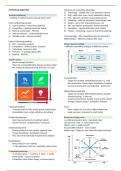8 STRATEGIC DIRECTION Influences on competitive advantage
1) Technology – reliable, flexi, cost, patented, expense
Strategic positioning 2) Staff – skills, flexi, innov, costs, motivation, training
= compete in market to gain comp adv (core comp) 3) R+D – lifecycles, demand, no guarantee success
4) Marketing – sales vol, awareness, brand image, copy
Factors influencing markets 5) Quality – price, USP, improved process, cost
1) Type of product – mass/niche, B2B/B2C 6) HR – recruitment, productivity, workers poached
2) Competition – growing/saturated market 7) Operations – capacity utilisation, stock control
3) External environment – PESTLEC 8) Finance – monitoring, resources diverted to planning
4) Internal resources – small production niche
5) Attitude to risk – unknown markets Cost advantage – offer competitive price for similar (EJ)
Differentiation – different products offer value
Factors influencing products
1) R+D – innovative products Porters’ generic strategy
2) Competitors – similar product, reactions = different competitive strategies in different markets
3) Technology – keep up to date
4) Finances – ↑ working capital, NPD
5) External – PESTLEC
Ansoff’s matrix
- decide strategic direction
- Show risk, oversimplification, changes working capital
- KFC market development in UK, franchise, no comp
Cost leadership
- Target mass market, standardised product (↓ cost)
- New production, cheap supply, distribution, transport
- Hard to be permanent cost leadership – patent, EoS
Differentiation leadership
- Target mass market, differentiated product (quality)
- Premium pricing, ↑ sales vol
- Superior performance, durable, brand, promo, distrib
- Change consumer tastes + competitor imitation
Market penetration Focus
- ↑ market share in exist market (grow), brand loyalty - Niche markets for cost adv or differentiation adv
- Consolidation (core comp), withdraw, do nothing - Loyal customers, dominant in small market
Product development Bowmans strategic clock
- New/improved products in existing markets = positioning based on price + perceived value
- Shorten lifecycle, complimentary = comp adv Low price low value - ↑ sales volume, EoS
Hybrid – price + quality benefit
Market development Focused differentiation – niche market
- Existing products in new market/ segment (exp) Bottom right – high price low value fails unless monopoly
- Change advertising + distribution channels
- May not be internationally accepted if not adapted
Diversification
- New products in new markets
- ↑ risk, experience, R+D cost, acquisition, dilute brand
Competitive advantage
- ↑ vol at low price = ↑ profit or ↑ price = ↑ profit
- Brand loyalty – repeat customers
- Competitors copy, tastes change, economy (luxury)




